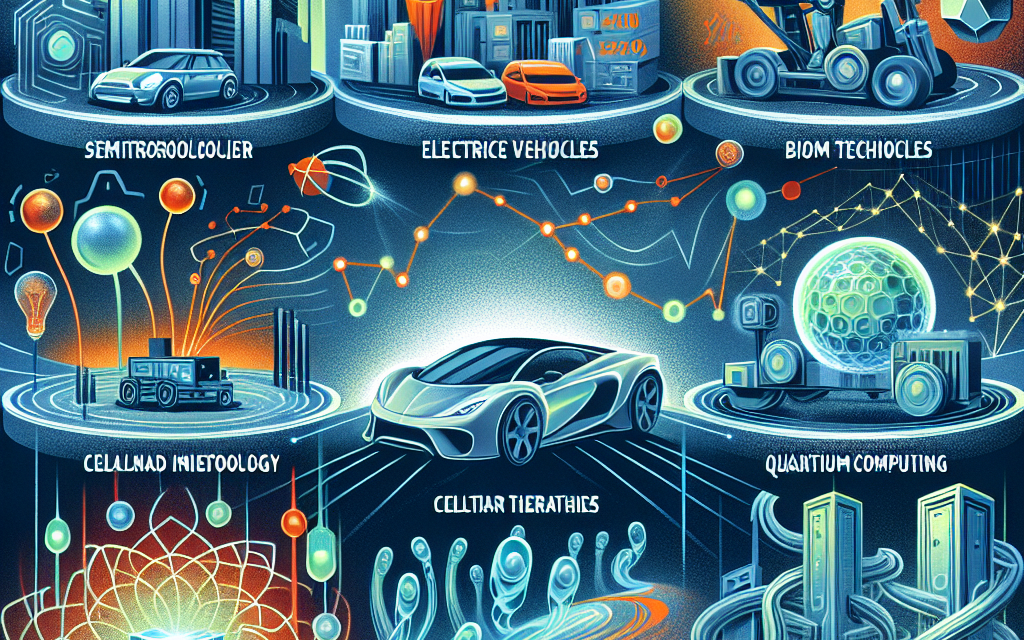“Market Momentum: Nvidia, Tesla, Moderna, and More Drive Today’s Top Movers!”
Introduction
Today’s top movers in the stock market include a diverse range of companies, each making significant impacts in their respective sectors. Nvidia continues to lead in the tech space with its advancements in AI and graphics processing, while Tesla remains a key player in the electric vehicle market, showcasing strong sales and innovation. Moderna is in the spotlight due to its ongoing developments in mRNA technology, particularly in vaccines. Intra-Cellular Therapies is gaining attention for its progress in mental health treatments. D-Wave Quantum is making waves in the quantum computing arena, and Edison is focused on energy solutions. U.S. Steel is responding to market demands and trends in the manufacturing sector. Together, these companies reflect the dynamic nature of today’s financial landscape, driven by technological advancements and evolving consumer needs.
Nvidia’s Dominance in AI and Gaming Markets
Nvidia has solidified its position as a dominant force in both the artificial intelligence (AI) and gaming markets, showcasing remarkable growth and innovation that has captured the attention of investors and industry experts alike. The company’s strategic focus on developing cutting-edge graphics processing units (GPUs) has not only revolutionized gaming experiences but has also positioned Nvidia as a key player in the burgeoning AI sector. As demand for AI technologies continues to surge, Nvidia’s GPUs have become essential for powering complex algorithms and machine learning applications, further enhancing the company’s market presence.
One of the primary drivers of Nvidia’s success in the AI domain is its ability to deliver high-performance computing solutions that cater to a wide range of applications. From data centers to autonomous vehicles, Nvidia’s technology is at the forefront of AI advancements. The introduction of the Nvidia A100 Tensor Core GPU, for instance, has enabled organizations to accelerate their AI workloads significantly, allowing for faster data processing and improved model training. This capability has attracted a diverse clientele, including major tech companies and research institutions, all eager to leverage Nvidia’s technology to enhance their AI initiatives.
Moreover, Nvidia’s commitment to innovation is evident in its continuous investment in research and development. The company has consistently pushed the boundaries of what is possible in GPU technology, leading to breakthroughs that have set new industry standards. For example, the recent launch of the Nvidia GeForce RTX 40 series has not only elevated gaming graphics to unprecedented levels but has also integrated AI-driven features that enhance gameplay experiences. This dual focus on gaming and AI has allowed Nvidia to capture a broad audience, from casual gamers to professional developers, thereby expanding its market reach.
In addition to its technological advancements, Nvidia has also strategically positioned itself through partnerships and collaborations. By aligning with key players in various industries, the company has been able to extend its influence and drive the adoption of its products. Collaborations with cloud service providers, for instance, have facilitated the integration of Nvidia’s GPUs into cloud-based AI solutions, making it easier for businesses to access powerful computing resources without the need for significant upfront investments. This approach not only enhances Nvidia’s revenue streams but also reinforces its status as a leader in the AI landscape.
Furthermore, the gaming sector remains a vital component of Nvidia’s business model. The company’s GPUs are widely regarded as the gold standard for gaming performance, and its GeForce brand has become synonymous with high-quality gaming experiences. As the gaming industry continues to evolve, with the rise of virtual reality and esports, Nvidia is well-positioned to capitalize on these trends. The company’s ongoing efforts to enhance its gaming technology, coupled with its strong brand loyalty among gamers, ensure that it remains a formidable competitor in this space.
In conclusion, Nvidia’s dominance in the AI and gaming markets is a testament to its innovative spirit and strategic foresight. By continuously pushing the envelope in GPU technology and fostering key partnerships, the company has established itself as a leader in both sectors. As the demand for AI solutions and immersive gaming experiences continues to grow, Nvidia’s ability to adapt and innovate will likely keep it at the forefront of these dynamic industries. Investors and stakeholders alike will be watching closely as Nvidia navigates the evolving landscape, poised to seize new opportunities and maintain its competitive edge.
Tesla’s Innovations in Electric Vehicles and Energy Solutions
Tesla has emerged as a leader in the electric vehicle (EV) market, consistently pushing the boundaries of innovation and sustainability. The company’s commitment to revolutionizing transportation is evident in its cutting-edge technology and forward-thinking approach to energy solutions. As the demand for electric vehicles continues to rise, Tesla has positioned itself at the forefront of this transformation, not only through its impressive lineup of vehicles but also by integrating energy solutions that complement its automotive offerings.
One of the most significant innovations from Tesla is its development of high-performance electric vehicles that cater to a diverse range of consumers. The introduction of models such as the Model S, Model 3, Model X, and Model Y has demonstrated Tesla’s ability to combine luxury, performance, and sustainability. Each vehicle is equipped with advanced features, including Autopilot, which enhances safety and convenience through semi-autonomous driving capabilities. This technology not only sets Tesla apart from traditional automakers but also underscores the company’s commitment to making electric vehicles more accessible and appealing to a broader audience.
In addition to its automotive innovations, Tesla has made substantial strides in energy solutions, particularly through its solar products and energy storage systems. The Tesla Solar Roof, for instance, represents a significant leap forward in harnessing solar energy for residential use. By integrating solar panels into roof tiles, Tesla has created a visually appealing alternative to traditional solar installations, allowing homeowners to generate clean energy without compromising aesthetics. This innovation aligns with Tesla’s mission to accelerate the world’s transition to sustainable energy, making it easier for consumers to adopt renewable energy sources.
Moreover, Tesla’s energy storage solutions, such as the Powerwall and Powerpack, have transformed the way individuals and businesses manage energy consumption. These systems store excess energy generated from solar panels or the grid, enabling users to utilize that energy during peak demand times or outages. By providing a reliable backup power source, Tesla empowers consumers to take control of their energy usage while reducing reliance on fossil fuels. This integration of energy generation and storage exemplifies Tesla’s holistic approach to sustainability, addressing both transportation and energy needs.
As Tesla continues to innovate, it is also expanding its manufacturing capabilities to meet the growing demand for electric vehicles and energy products. The establishment of Gigafactories around the world has enabled the company to scale production efficiently while reducing costs. These facilities not only produce vehicles but also manufacture battery cells and energy storage systems, further solidifying Tesla’s position as a key player in the renewable energy sector. The focus on vertical integration allows Tesla to maintain quality control and drive down prices, making electric vehicles and energy solutions more accessible to consumers.
In conclusion, Tesla’s innovations in electric vehicles and energy solutions reflect a comprehensive strategy aimed at fostering a sustainable future. By combining advanced automotive technology with renewable energy products, Tesla is not only reshaping the transportation landscape but also contributing to a broader shift towards sustainability. As the company continues to push the envelope in both sectors, it remains poised to play a pivotal role in the global transition to clean energy, inspiring other industries to follow suit. The ongoing advancements from Tesla serve as a testament to the potential of innovation in addressing some of the most pressing challenges of our time, ultimately paving the way for a more sustainable and environmentally friendly future.
Moderna’s Advancements in mRNA Technology Beyond COVID-19
Moderna, a biotechnology company renowned for its pioneering work in messenger RNA (mRNA) technology, has made significant strides beyond its initial focus on COVID-19 vaccines. The success of its vaccine has not only established Moderna as a leader in the field but has also opened new avenues for the application of mRNA technology in various therapeutic areas. As the company continues to innovate, it is exploring the potential of mRNA to address a range of diseases, including cancer, infectious diseases, and rare genetic disorders.
One of the most promising areas of research for Moderna is cancer immunotherapy. The company is developing personalized cancer vaccines that leverage the unique genetic makeup of an individual’s tumor. By using mRNA to instruct the body’s immune system to recognize and attack cancer cells, these vaccines aim to enhance the body’s natural defenses. This approach is particularly compelling because it tailors treatment to the specific mutations present in a patient’s tumor, potentially leading to more effective and targeted therapies. Early clinical trials have shown encouraging results, indicating that mRNA-based vaccines can elicit robust immune responses against various types of cancer.
In addition to oncology, Moderna is also expanding its mRNA platform to tackle infectious diseases beyond COVID-19. The company is actively working on vaccines for diseases such as influenza, Zika virus, and cytomegalovirus. The flexibility of mRNA technology allows for rapid development and adaptation of vaccines in response to emerging infectious threats. For instance, Moderna’s work on an mRNA flu vaccine aims to provide broader protection against multiple strains of the virus, which could significantly improve seasonal vaccination efforts. This adaptability is crucial in a world where pathogens can evolve quickly, necessitating a swift response from the scientific community.
Moreover, Moderna is venturing into the realm of rare genetic disorders, where mRNA technology holds the potential to correct or mitigate the effects of genetic mutations. By delivering mRNA that encodes functional proteins, the company aims to address the underlying causes of these disorders. This innovative approach could transform the treatment landscape for conditions that currently have limited or no therapeutic options. As research progresses, the implications of such advancements could be profound, offering hope to patients and families affected by these challenging diseases.
Furthermore, Moderna’s commitment to advancing mRNA technology is underscored by its ongoing collaborations with various academic institutions and industry partners. These partnerships are essential for accelerating research and development efforts, as they bring together diverse expertise and resources. By fostering a collaborative environment, Moderna is not only enhancing its own capabilities but also contributing to the broader scientific community’s understanding of mRNA applications.
As Moderna continues to push the boundaries of mRNA technology, it is clear that the company is poised to play a pivotal role in the future of medicine. The potential applications of mRNA extend far beyond the COVID-19 pandemic, encompassing a wide array of therapeutic areas that could revolutionize how diseases are treated. With ongoing research and clinical trials, the promise of mRNA technology is becoming increasingly tangible, offering new hope for patients worldwide. In this rapidly evolving landscape, Moderna’s advancements serve as a testament to the transformative power of innovation in biotechnology, highlighting the importance of continued investment in research and development to unlock the full potential of mRNA.
Intra-Cellular Therapies: Breakthroughs in Mental Health Treatments
Intra-Cellular Therapies has emerged as a significant player in the field of mental health treatments, particularly with its innovative approaches to addressing complex psychiatric disorders. The company has garnered attention for its commitment to developing novel therapies that target the underlying mechanisms of mental health conditions, rather than merely alleviating symptoms. This focus on the root causes of disorders such as schizophrenia and bipolar depression has positioned Intra-Cellular Therapies at the forefront of psychiatric research and development.
One of the most notable advancements from Intra-Cellular Therapies is its lead product candidate, lumateperone, which has shown promise in clinical trials for the treatment of schizophrenia. Lumateperone operates through a unique mechanism of action that involves modulating multiple neurotransmitter systems, including dopamine and serotonin. This multifaceted approach is particularly significant, as traditional antipsychotic medications often target only dopamine receptors, leading to a range of side effects and limitations in efficacy. By contrast, lumateperone has demonstrated a favorable safety profile, with a lower incidence of extrapyramidal symptoms, which are common side effects associated with many existing antipsychotic treatments.
Furthermore, the approval of lumateperone by the U.S. Food and Drug Administration (FDA) in late 2019 marked a pivotal moment for Intra-Cellular Therapies and the broader mental health landscape. This approval not only validated the company’s research efforts but also provided a new therapeutic option for patients suffering from schizophrenia, a condition that affects millions worldwide. The positive reception of lumateperone has sparked interest among healthcare providers and patients alike, as it represents a shift towards more effective and tolerable treatment options.
In addition to its work on schizophrenia, Intra-Cellular Therapies is also exploring the potential of lumateperone in treating bipolar depression. This area of research is particularly critical, as bipolar disorder is often characterized by debilitating mood swings that can severely impact an individual’s quality of life. The company’s ongoing clinical trials aim to assess the efficacy and safety of lumateperone in this context, with the hope of providing a much-needed solution for those who struggle with the depressive episodes associated with bipolar disorder.
Moreover, Intra-Cellular Therapies is not resting on its laurels; it continues to invest in research and development to expand its pipeline of potential treatments. The company is exploring additional indications and formulations that could further enhance its therapeutic offerings. This proactive approach underscores its commitment to addressing the unmet needs in mental health care, an area that has historically been underfunded and overlooked.
As the conversation around mental health continues to evolve, the role of innovative companies like Intra-Cellular Therapies becomes increasingly vital. The stigma surrounding mental health disorders is gradually diminishing, leading to greater awareness and demand for effective treatments. In this context, the breakthroughs achieved by Intra-Cellular Therapies not only represent scientific progress but also offer hope to countless individuals and families affected by mental health issues.
In conclusion, Intra-Cellular Therapies stands out as a beacon of innovation in the mental health treatment landscape. With its focus on developing therapies that address the complexities of psychiatric disorders, the company is poised to make a lasting impact on the lives of those who suffer from these conditions. As it continues to advance its research and expand its therapeutic offerings, Intra-Cellular Therapies exemplifies the potential for transformative change in mental health care.
D-Wave Quantum’s Role in Advancing Quantum Computing
D-Wave Quantum has emerged as a pivotal player in the rapidly evolving field of quantum computing, a domain that promises to revolutionize various industries by solving complex problems that are currently beyond the reach of classical computers. As the first company to offer a commercially available quantum computer, D-Wave has positioned itself at the forefront of this technological frontier, enabling organizations to harness the power of quantum mechanics for practical applications. The company’s unique approach to quantum computing, which focuses on quantum annealing, allows it to tackle optimization problems efficiently, making it particularly valuable for sectors such as finance, logistics, and pharmaceuticals.
One of the key aspects of D-Wave’s technology is its ability to perform computations that involve vast amounts of data and numerous variables. Traditional computers struggle with these types of problems, often requiring an impractical amount of time to arrive at a solution. In contrast, D-Wave’s quantum systems can explore multiple solutions simultaneously, significantly reducing the time needed to find optimal outcomes. This capability is particularly beneficial in industries where decision-making is critical and time-sensitive, such as supply chain management and risk assessment in finance.
Moreover, D-Wave has made significant strides in enhancing the accessibility of quantum computing through its cloud-based platform, Leap. This platform allows developers and researchers to access quantum computing resources without the need for extensive hardware investments. By democratizing access to quantum technology, D-Wave is fostering innovation and collaboration across various sectors, encouraging businesses and academic institutions to experiment with quantum algorithms and applications. This initiative not only accelerates the development of quantum solutions but also cultivates a broader understanding of quantum computing’s potential.
In addition to its technological advancements, D-Wave has established strategic partnerships with leading organizations and research institutions. These collaborations are instrumental in driving the practical application of quantum computing across diverse fields. For instance, partnerships with companies in the aerospace and automotive industries have led to the exploration of quantum solutions for complex design and optimization challenges. By working alongside industry leaders, D-Wave is not only validating its technology but also contributing to the development of real-world applications that can transform business operations.
Furthermore, D-Wave’s commitment to research and development is evident in its ongoing efforts to enhance the performance and scalability of its quantum systems. The company continually invests in improving its quantum hardware and software, ensuring that it remains competitive in a rapidly advancing field. As quantum computing technology matures, D-Wave is poised to play a crucial role in shaping the future of computing, particularly as more organizations recognize the potential benefits of integrating quantum solutions into their operations.
As the landscape of technology continues to evolve, D-Wave Quantum stands out as a beacon of innovation in the quantum computing arena. Its pioneering efforts not only highlight the transformative potential of quantum technology but also underscore the importance of collaboration and accessibility in driving progress. As businesses and researchers increasingly turn to quantum computing to solve complex challenges, D-Wave’s contributions will undoubtedly play a significant role in advancing this exciting field. In conclusion, D-Wave Quantum’s commitment to innovation, collaboration, and accessibility positions it as a leader in the quest to unlock the full potential of quantum computing, paving the way for a future where complex problem-solving is not just a dream but a reality.
Edison’s Impact on Renewable Energy and Smart Grids
Edison’s impact on renewable energy and smart grids is profound, as his pioneering work laid the groundwork for modern electrical systems. While Thomas Edison is often celebrated for his invention of the electric light bulb, his contributions extend far beyond this iconic creation. He was instrumental in developing the first practical electric power distribution system, which has evolved significantly over the years. Today, as the world grapples with the pressing need for sustainable energy solutions, Edison’s legacy is more relevant than ever, particularly in the context of renewable energy and smart grid technologies.
In recent years, the shift towards renewable energy sources such as solar, wind, and hydroelectric power has gained momentum. This transition is crucial for reducing greenhouse gas emissions and combating climate change. Edison’s early work in electrical distribution systems has been adapted to accommodate these renewable sources, enabling a more decentralized and resilient energy infrastructure. For instance, solar panels can now be integrated into the grid, allowing homeowners to generate their own electricity while contributing excess power back to the system. This not only empowers consumers but also enhances the overall efficiency of energy distribution.
Moreover, the concept of smart grids has emerged as a vital component of modern energy management. Smart grids utilize advanced technologies, including sensors, smart meters, and automated controls, to optimize the generation, distribution, and consumption of electricity. Edison’s vision of a reliable and efficient electrical system is being realized through these innovations, which facilitate real-time monitoring and management of energy resources. By leveraging data analytics and communication technologies, smart grids can respond dynamically to fluctuations in energy demand and supply, thereby improving reliability and reducing costs.
As we delve deeper into the implications of Edison’s contributions, it becomes evident that his influence extends to the integration of energy storage solutions. Energy storage technologies, such as batteries, play a crucial role in balancing supply and demand, particularly with intermittent renewable sources like solar and wind. Edison’s early experiments with electricity storage have paved the way for modern advancements in this field, enabling a more stable and flexible energy system. By storing excess energy generated during peak production times, these technologies ensure that power is available when it is most needed, thus enhancing grid reliability.
Furthermore, Edison’s emphasis on innovation and experimentation resonates with today’s focus on research and development in the energy sector. Companies and governments are investing heavily in new technologies that can further enhance the efficiency and sustainability of energy systems. This commitment to innovation is essential for addressing the challenges posed by climate change and the growing demand for energy. Edison’s legacy serves as a reminder of the importance of creativity and perseverance in the pursuit of technological advancements.
In conclusion, Edison’s impact on renewable energy and smart grids is a testament to his visionary thinking and commitment to improving electrical systems. His foundational work has not only shaped the way we generate and distribute electricity but has also inspired ongoing innovations that are crucial for a sustainable future. As we continue to navigate the complexities of modern energy challenges, Edison’s contributions remain a guiding force, reminding us of the potential for technology to transform our world for the better. The ongoing evolution of energy systems, driven by the principles he championed, underscores the importance of embracing renewable sources and smart technologies in our quest for a cleaner, more efficient energy landscape.
U.S. Steel’s Strategies for Sustainability and Industry Growth
U.S. Steel has increasingly positioned itself at the forefront of sustainability and industry growth, recognizing the critical importance of environmental stewardship in today’s manufacturing landscape. As global awareness of climate change intensifies, the steel industry faces mounting pressure to reduce its carbon footprint and adopt more sustainable practices. U.S. Steel has responded to this challenge by implementing a comprehensive strategy that not only addresses environmental concerns but also enhances its competitive edge in the market.
One of the cornerstone initiatives of U.S. Steel’s sustainability strategy is its commitment to reducing greenhouse gas emissions. The company has set ambitious targets to achieve net-zero emissions by 2050, aligning its goals with broader global efforts to combat climate change. This commitment is not merely aspirational; it is backed by concrete actions, including investments in advanced technologies and processes that minimize emissions during steel production. For instance, U.S. Steel is exploring the use of electric arc furnaces, which are significantly more energy-efficient than traditional blast furnaces and can utilize recycled scrap steel as a primary input. This shift not only reduces emissions but also conserves natural resources, thereby contributing to a circular economy.
In addition to its focus on emissions reduction, U.S. Steel is actively pursuing innovations in product development that cater to the growing demand for sustainable materials. The company has introduced a range of eco-friendly steel products designed to meet the needs of environmentally conscious consumers and industries. By prioritizing the development of high-strength, lightweight steel that can enhance energy efficiency in applications such as automotive manufacturing, U.S. Steel is positioning itself as a leader in sustainable steel solutions. This proactive approach not only addresses market demands but also reinforces the company’s reputation as a responsible corporate citizen.
Moreover, U.S. Steel recognizes that collaboration is essential for driving meaningful change within the industry. The company has engaged in partnerships with various stakeholders, including government agencies, research institutions, and other industry players, to foster innovation and share best practices in sustainability. These collaborations have led to the exploration of new technologies, such as carbon capture and storage, which have the potential to significantly reduce emissions from steel production. By working together with others in the industry, U.S. Steel is not only enhancing its own sustainability efforts but also contributing to the development of industry-wide standards that promote environmental responsibility.
Furthermore, U.S. Steel is committed to transparency and accountability in its sustainability initiatives. The company regularly publishes sustainability reports that detail its progress toward achieving its environmental goals, providing stakeholders with insights into its operations and impact. This level of transparency not only builds trust with investors and customers but also encourages continuous improvement within the organization. By openly sharing its successes and challenges, U.S. Steel demonstrates its dedication to responsible business practices and its willingness to adapt to the evolving landscape of the steel industry.
In conclusion, U.S. Steel’s strategies for sustainability and industry growth reflect a comprehensive approach that integrates environmental responsibility with business objectives. By focusing on emissions reduction, innovative product development, collaborative partnerships, and transparency, the company is not only addressing the pressing challenges of climate change but also positioning itself for long-term success in a competitive market. As the steel industry continues to evolve, U.S. Steel’s commitment to sustainability will undoubtedly play a pivotal role in shaping its future and ensuring its relevance in an increasingly eco-conscious world.
Q&A
1. **Nvidia**: What is the latest stock price movement for Nvidia?
**Answer**: Nvidia’s stock has increased by 3% today due to strong demand for its AI chips.
2. **Tesla**: What recent development has impacted Tesla’s stock?
**Answer**: Tesla’s stock rose by 2% following the announcement of a new battery technology that promises longer range.
3. **Moderna**: How has Moderna’s stock performed recently?
**Answer**: Moderna’s stock is up 4% after positive trial results for its new COVID-19 vaccine variant.
4. **Intra-Cellular Therapies**: What news has affected Intra-Cellular Therapies today?
**Answer**: Intra-Cellular Therapies shares surged 5% after receiving FDA approval for a new treatment for schizophrenia.
5. **D-Wave Quantum**: What is the latest update on D-Wave Quantum?
**Answer**: D-Wave Quantum’s stock jumped 6% following a partnership announcement with a major tech firm for quantum computing solutions.
6. **Edison**: What has influenced Edison’s stock price today?
**Answer**: Edison’s stock has declined by 2% due to regulatory concerns regarding its energy pricing model.
7. **U.S. Steel**: What is the current trend for U.S. Steel’s stock?
**Answer**: U.S. Steel’s stock is up 3% after reporting better-than-expected quarterly earnings.
Conclusion
Today’s top movers, including Nvidia, Tesla, Moderna, Intra-Cellular Therapies, D-Wave Quantum, Edison, and U.S. Steel, reflect a dynamic market influenced by technological advancements, healthcare developments, and industrial performance. Nvidia continues to lead in the tech sector with strong demand for its GPUs, while Tesla’s stock fluctuates amid ongoing discussions about electric vehicle market competition. Moderna’s performance is tied to vaccine developments, and Intra-Cellular Therapies shows promise in the biotech space. D-Wave Quantum’s innovations in quantum computing highlight the growing interest in this field, while Edison and U.S. Steel are impacted by energy and materials market trends. Overall, these companies illustrate the diverse factors driving market movements today, emphasizing the interplay between technology, healthcare, and industrial sectors.





